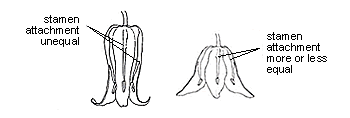Glossary
- Ancient woodland indicator
- n. Plants that are commonly found in woodland that have been in existence since at least 1600 AD. Ancient woodlands often have a rich variety of wild plants. As a rough guide, if the wood has three or more of the ten species listed in our guide, it can be considered ancient.
- Anther
- n. The part of the stamen that contains pollen.
- Basal
- adj. leaf. Located at or near the base of a plant. Arising, in bluebells, from the bulb.
- Bract
- n. A leaf-like or scale-like part, frequently small, sometimes brightly coloured, and located below a flower or flower stalk.
- Bulb
- n. bulbous adj. A short underground stem surrounded by fleshy leaf bases containing food stores.
- Bulb scales
- n. The succuluent structures that make up the bulb.
- Diameter
- n. (Abbr. d or diam.) A straight line passing through the centre of a figure, usually a circle or sphere.
- Endemic
- adj. Native to or confined to a particular region.
- Filament
- n.The part of the stamen that supports the anther, a stalk.
- Flower
- n. The reproductive structure of many plants, having either male (stamens) or female (pistil) organs or both male and female organs and normally enclosed by petals and sepals.
- Flower spike
- n. An elongated flower cluster (or inflorescence) with individual flowers borne on very short stalks (a raceme) or attached directly to the main stem (a spike).
- Flower stalk
- n. A stem-like structure that supports an individual flower.
- Genus
- n., genera pl. A category of classification ranking below a family and above a species and generally consisting of a group of species exhibiting similar characteristics.
- Inflorescence
- n. The flowering portion of the plant above the leaves, including its branches, bracts and flowers.
- Keel
- n. A ridge, like the keel of a boat.
- Herb
- n. A plant that does not produce woody tissue and dies back at the end of the growing season.
- Leaf
- n.
- leaves pl. A usually green, flattened, structure attached to the stem and functioning as a principal organ of photosynthesis and transpiration in most plants.
- linear adj. Narrow and elongated with nearly parallel margins.
- lanceolate adj. Tapering from a rounded base toward an apex; lance-shaped.
- acute adj. Having a sharp tip.
- blunt adj. Having a rounded, not sharp, tip.
- Native
- adj. Originating in a certain place or region; indigenous.
- Perennial
- adj. A plant that lives three or more years.
- Perianth
- n. The outer, usually showy, non-sexual parts of the flower.
- Petal
- n. One of the often brightly coloured parts of a flower surrounding the male and female organs.

- Pollen
- n. A fine powder which produces the male gametes (sperm cells) in flowers.
- Raceme
- n. A type of flower spike with stalked flowers arranged singly along an elongated unbranched stem.
- Species
- n., pl. A category of classification, ranking below a genus, consisting of closely related organisms capable of interbreeding. An organism belonging to a species is represented by an uncapitalized Latin name and a capitalized genus name, as in Hyacinthoides non-scripta, the bluebell.
- Stem
- n. The main axis of a plant, a stalk or trunk.
- Stamen
- n., stamens pl. The male reproductive organ(s) of a flower, usually consisting of a filament and an anther.

- Tepal
- n. The name given to the parts of the perianth when the outer sepals and inner petals are practically indistinguishable.
Toolbox

With our shark experts, Speedo developed a super-fast swimsuit – its special fabric mimics the microscopic features of sharks’ skin.